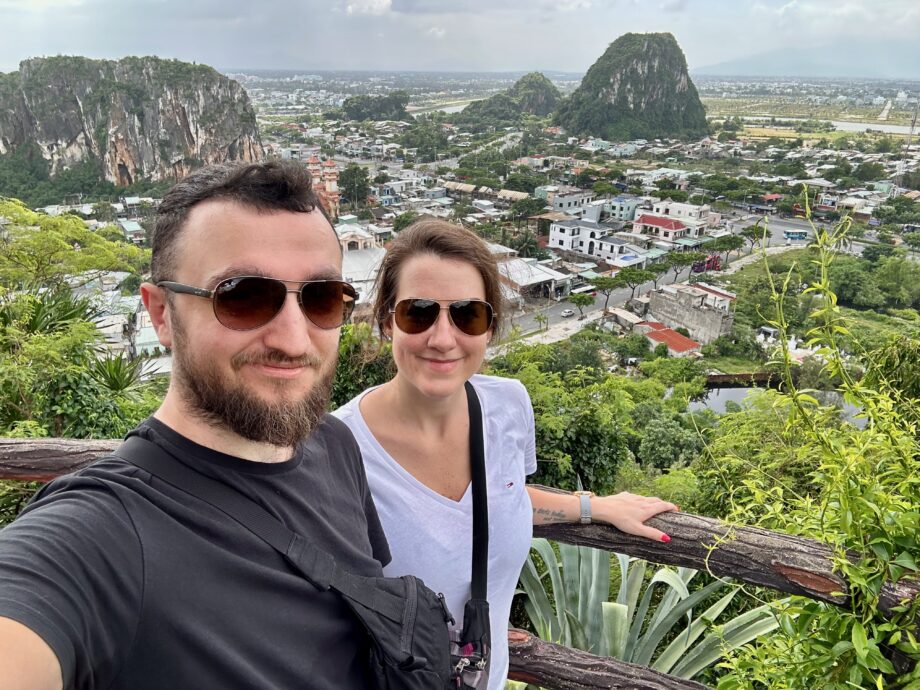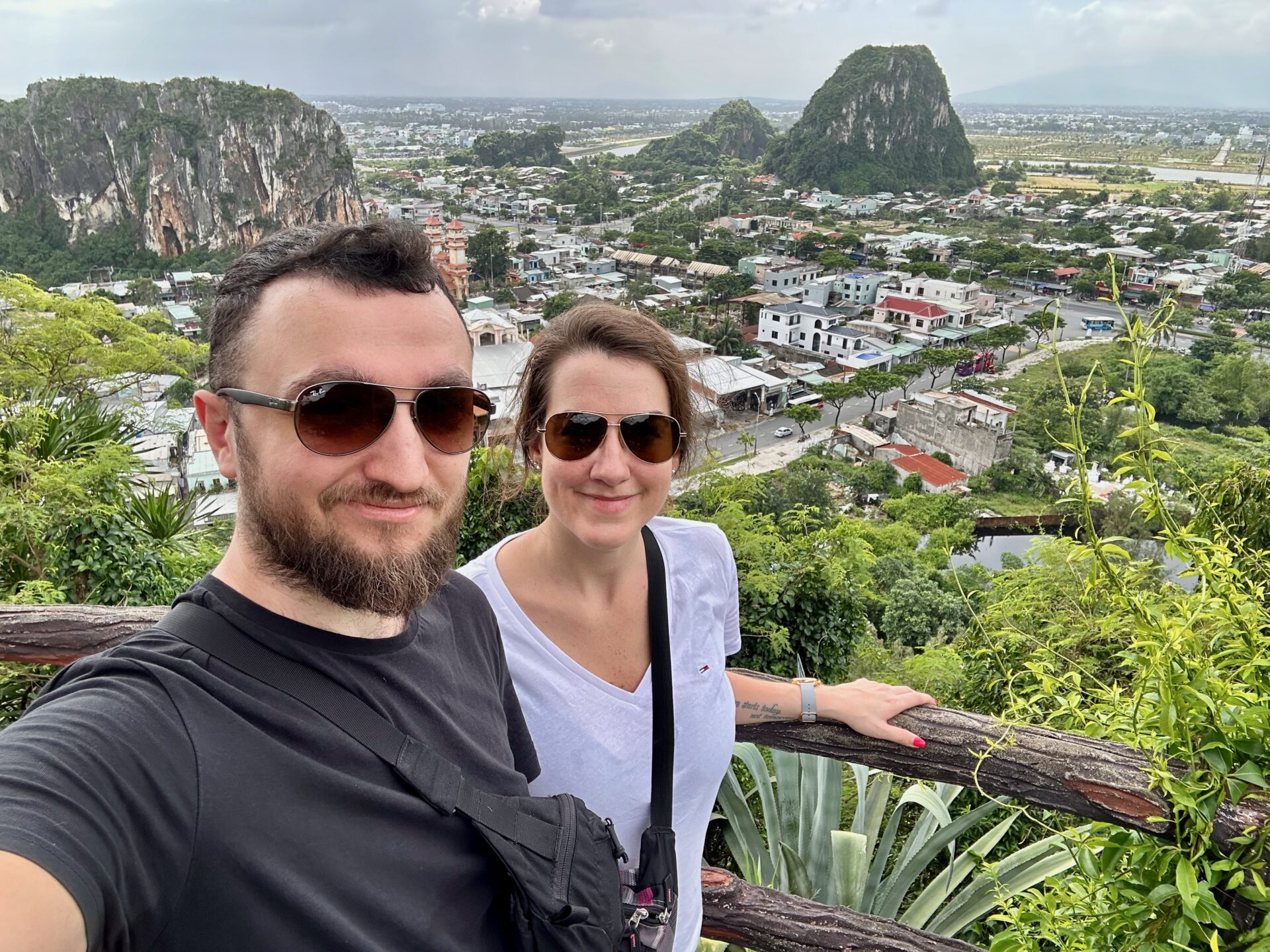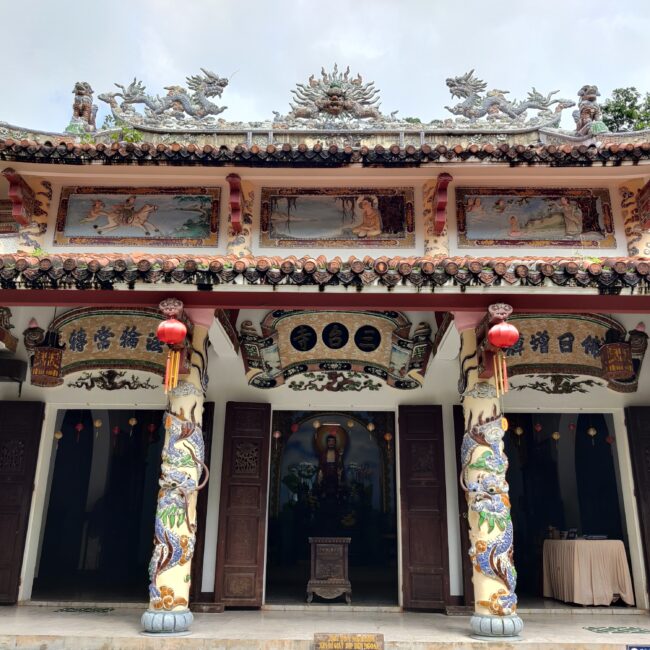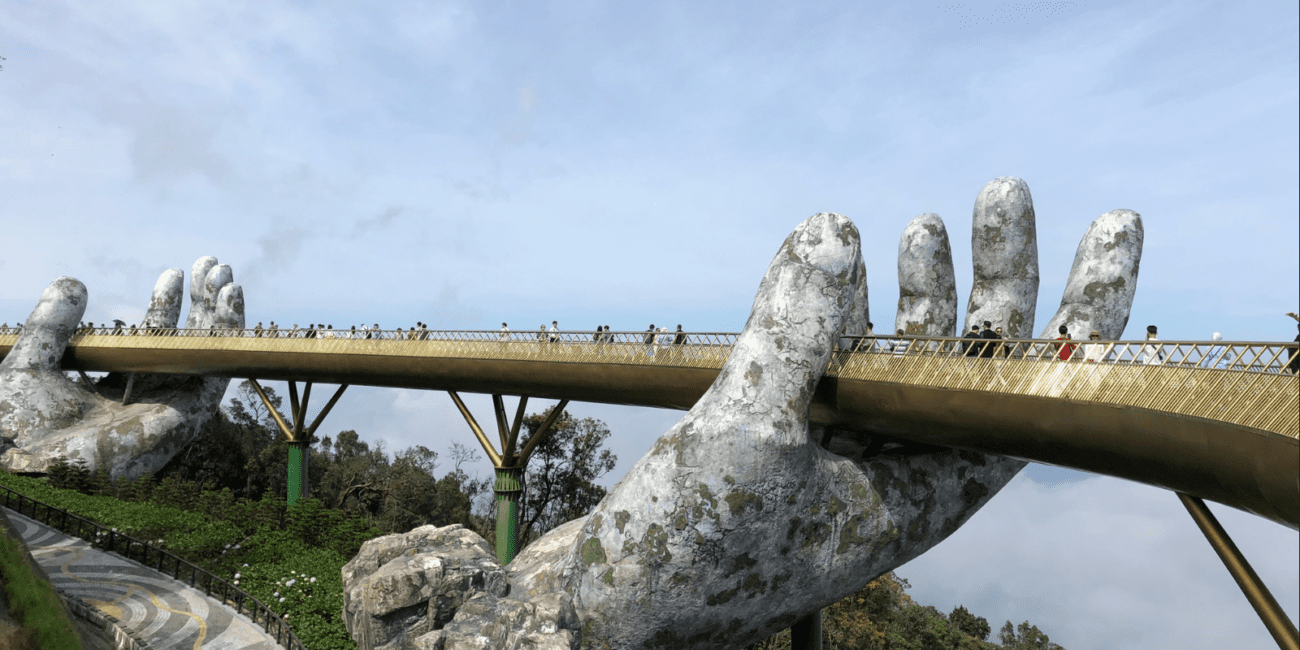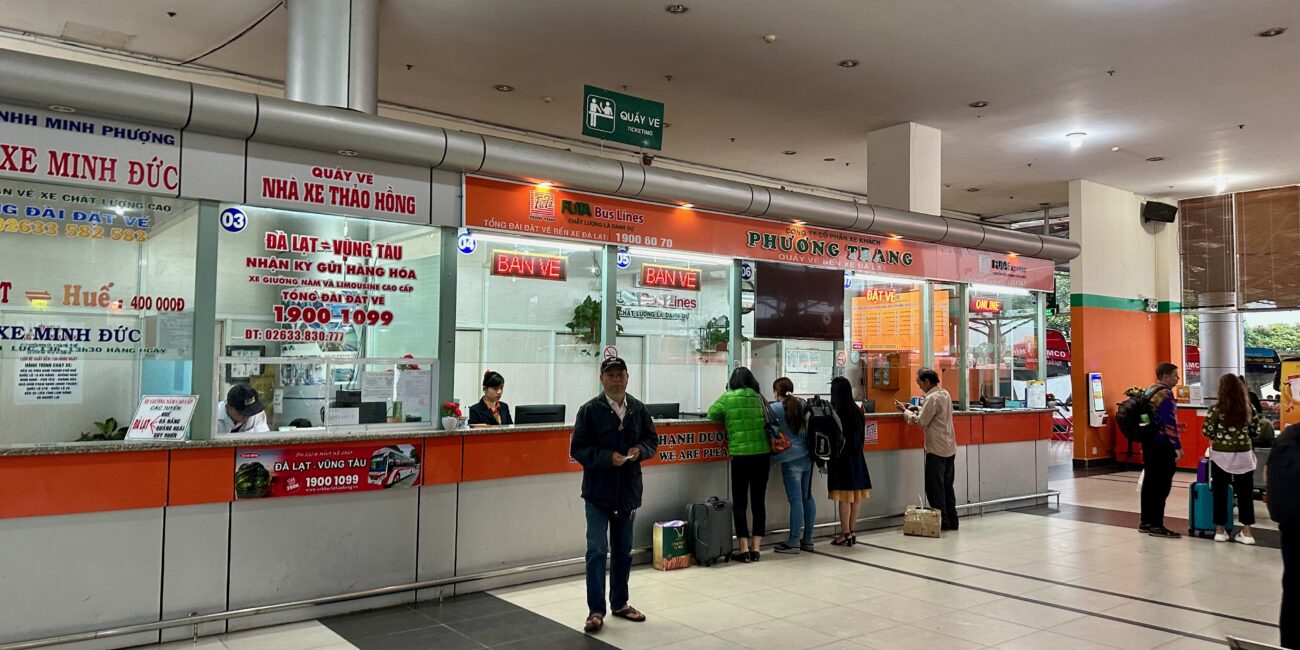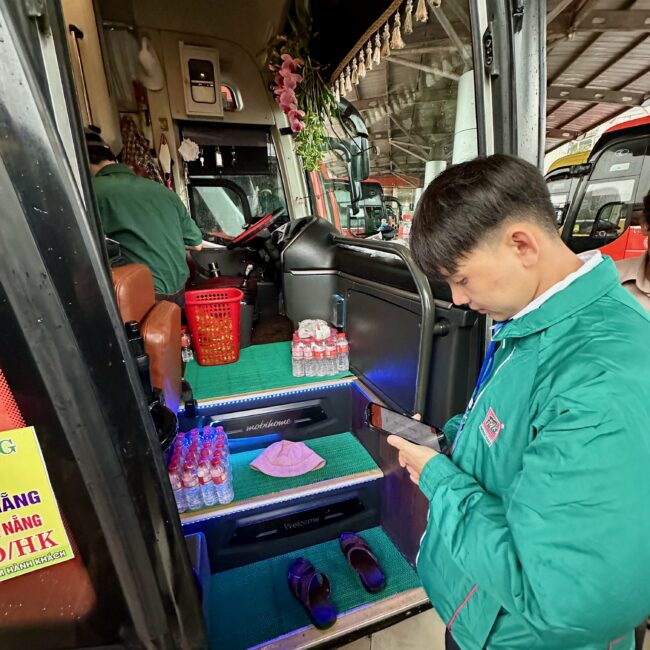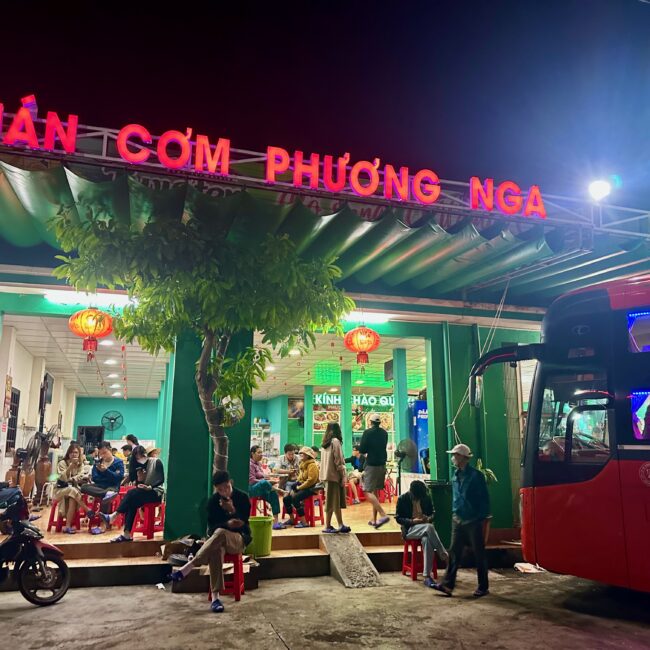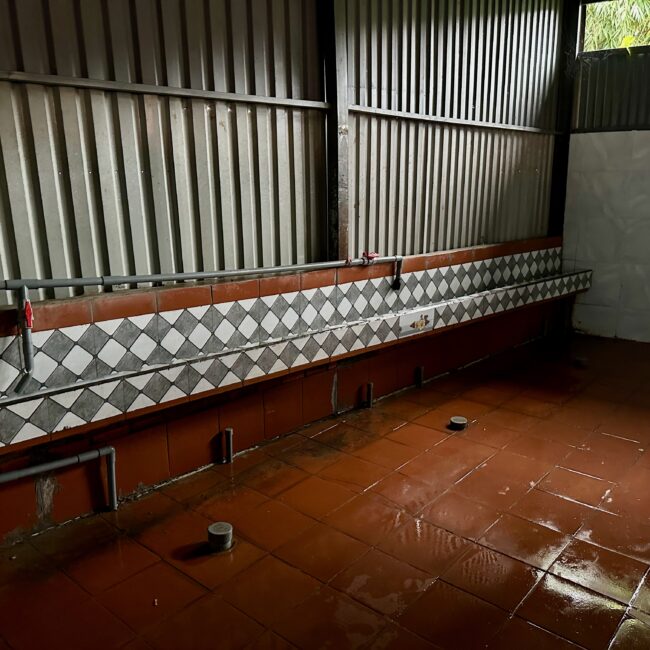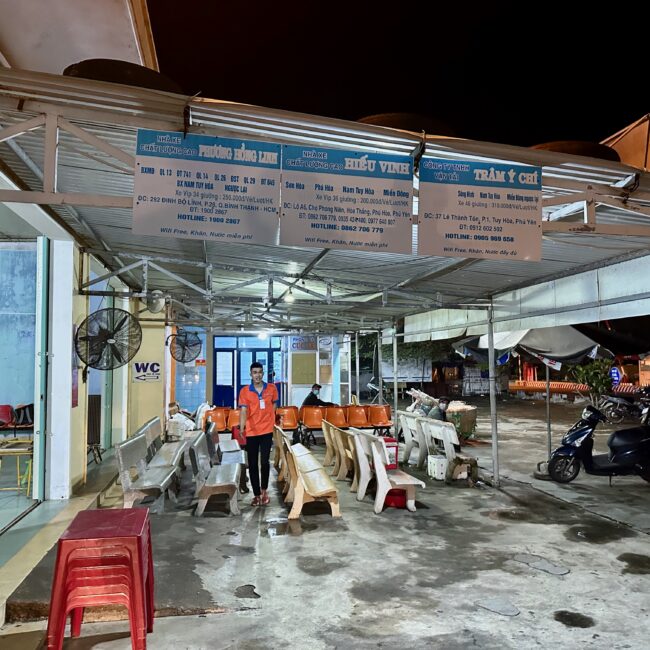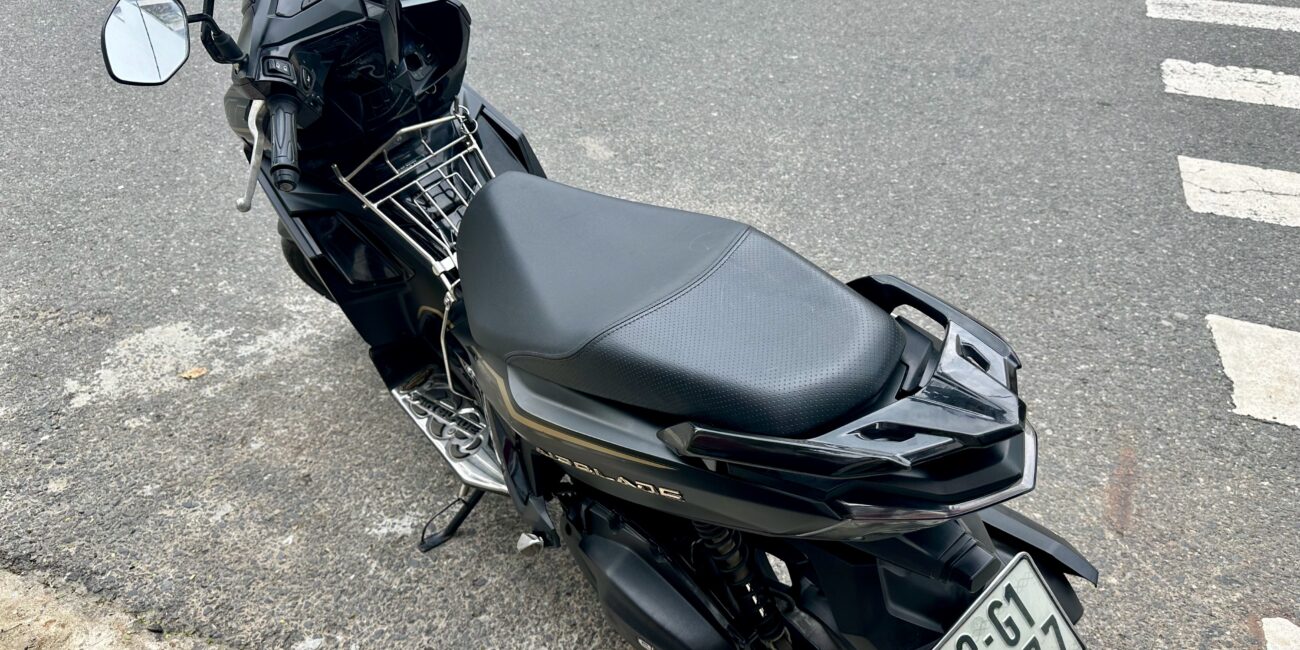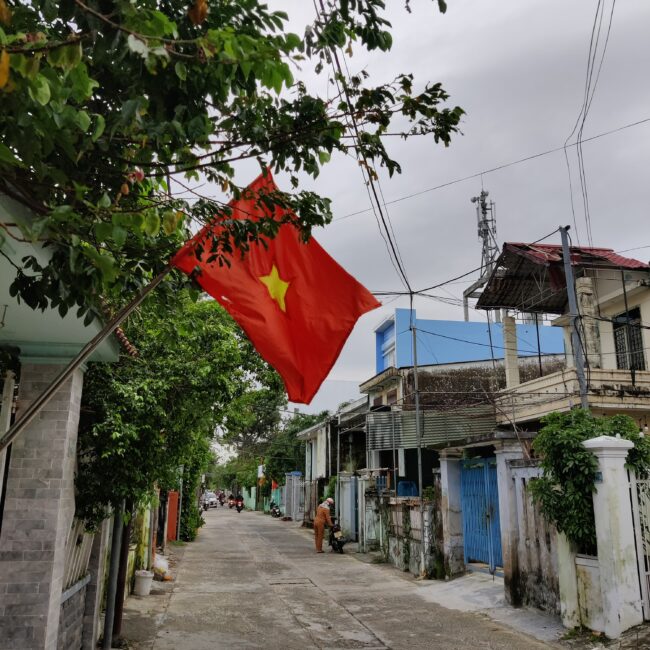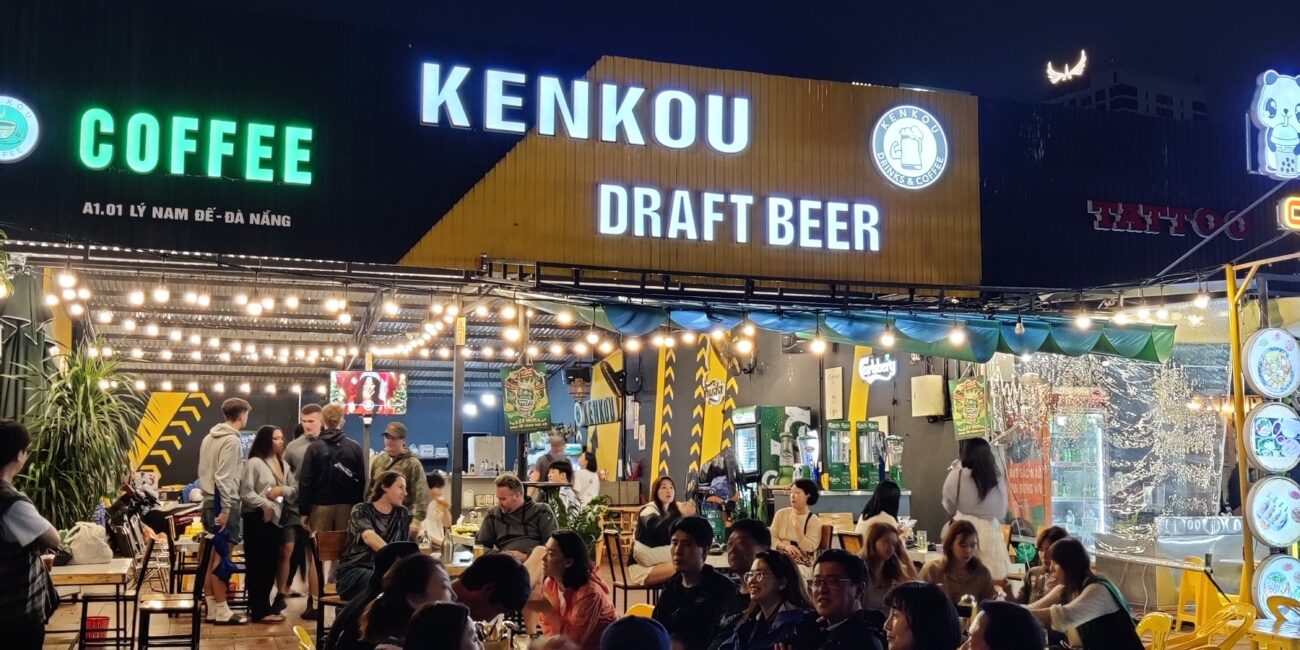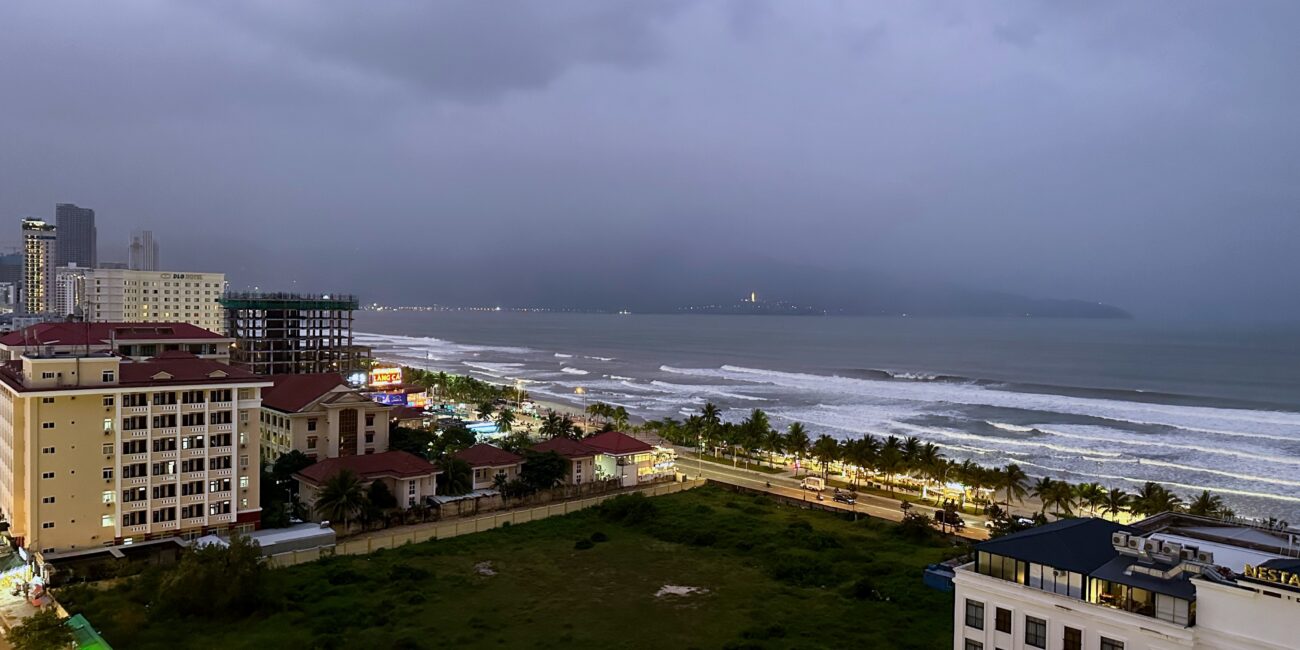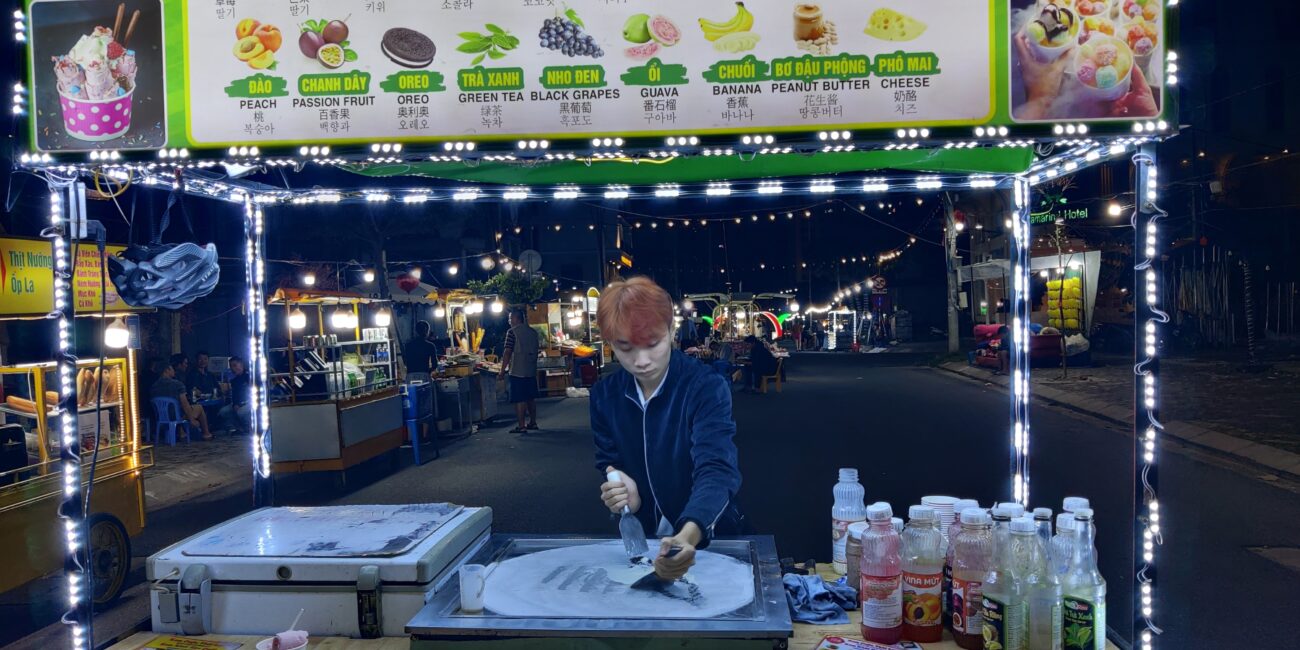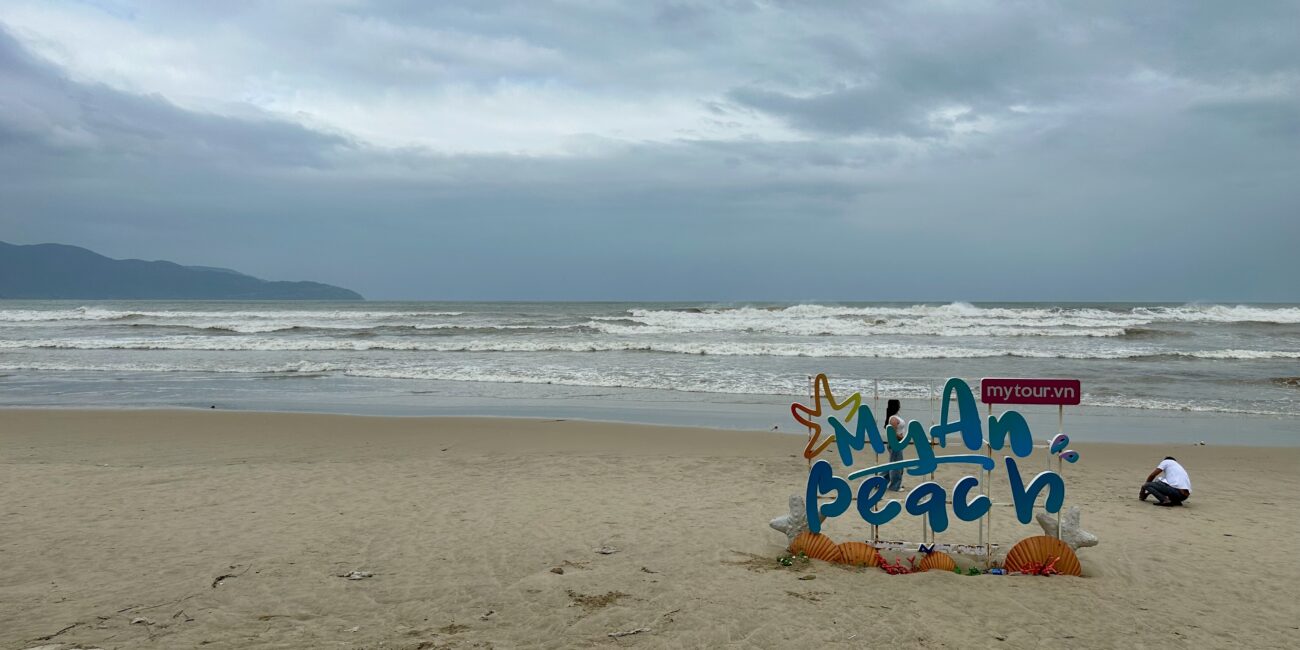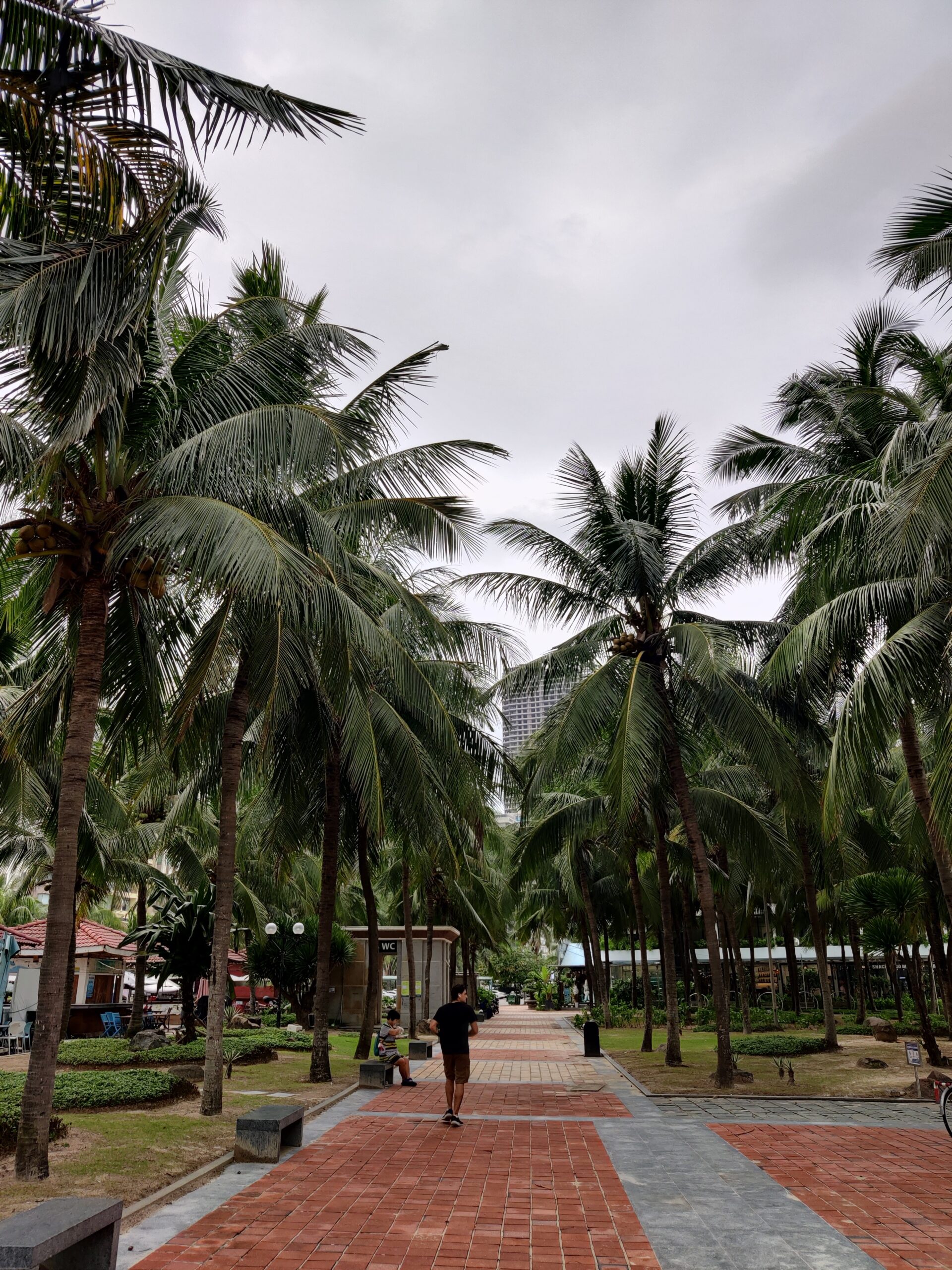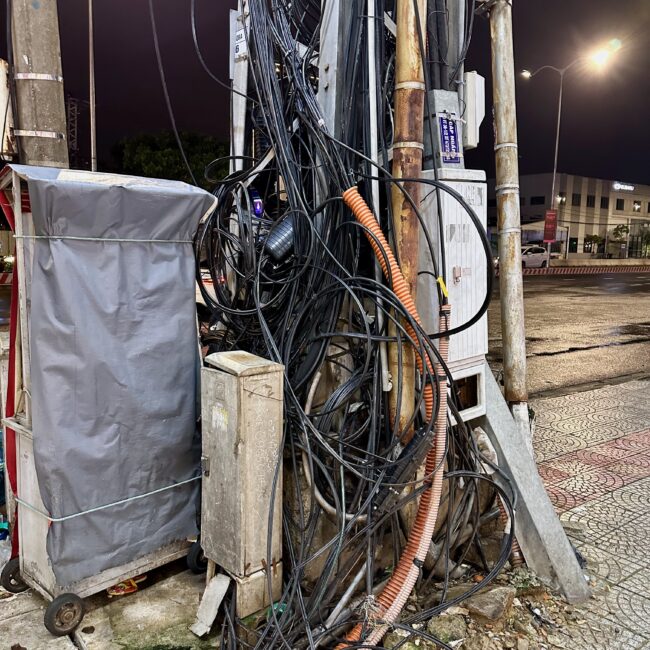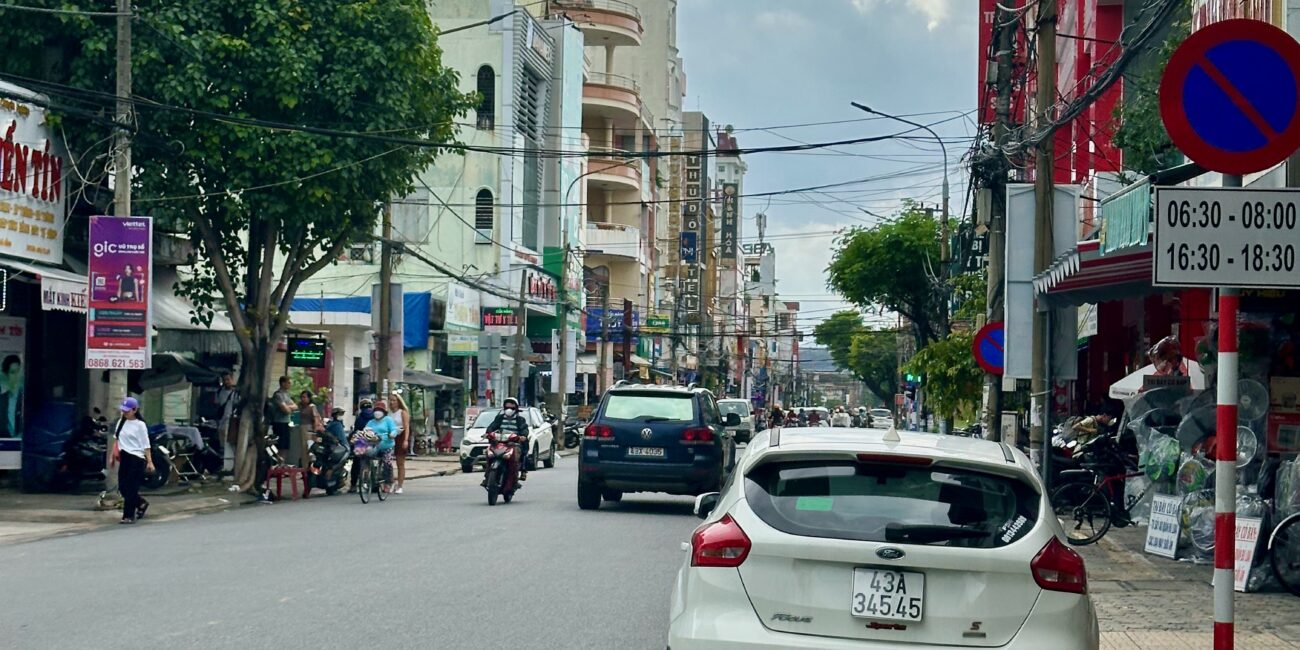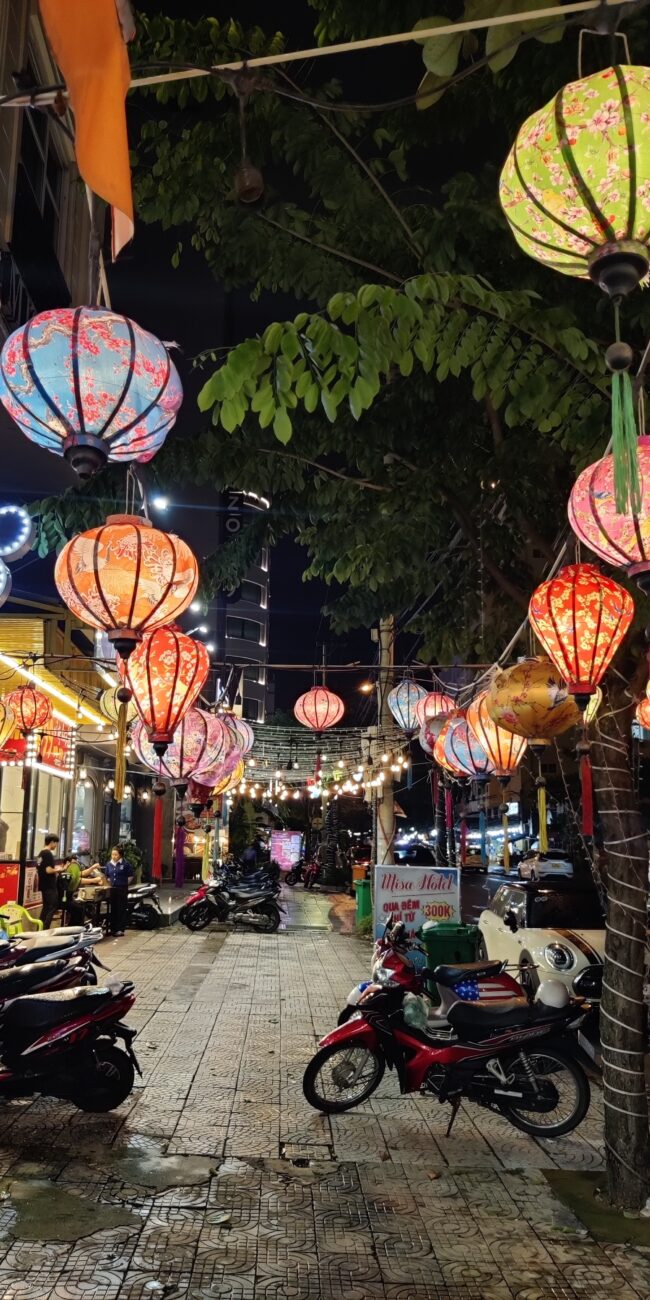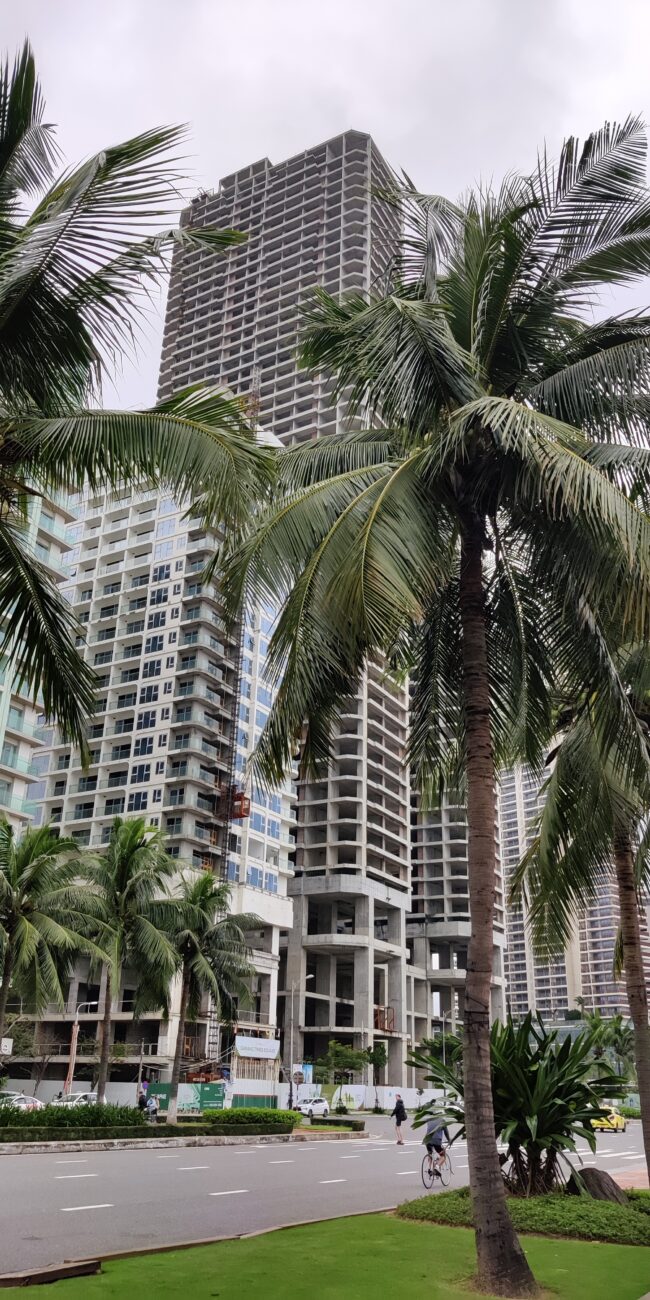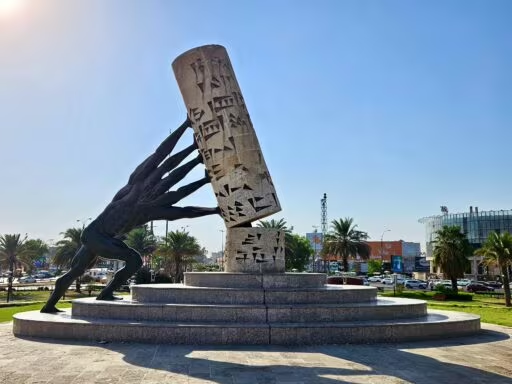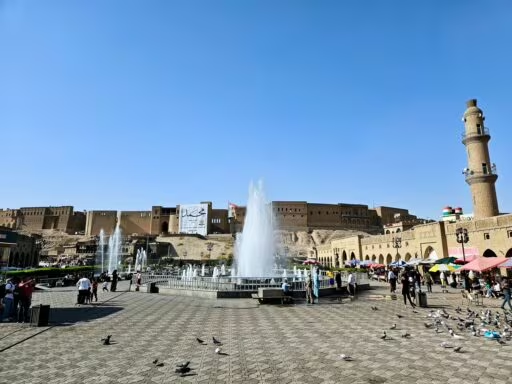This post is also available in:
Polski
Hello! 👋
This time, we’re taking you to Da Nang – the city that became our next stop. After spending a few days in Da Lat, we were wondering what the easiest and most economical way to get to Da Nang would be. There were a few options, but in the end, we decided on the bus.
During the planning, we also had to check the weather forecasts. During our stay near Da Nang, more specifically in Hue, floods occurred, which partly reached the outskirts of the city. Hue was on our itinerary, but due to the unfavorable weather conditions, we focused on exploring Da Nang itself.
It was a spontaneous decision, but as it turned out, a very good one. Da Nang had a few interesting places to offer, and we approached the exploration without much planning, which only added a relaxed vibe to the whole experience.
If you haven’t had a chance to read our previous coverage yet, be sure to take a look:
👉 Part 1: Ho Chi Minh City – the beginning of an adventure
👉 Part 2: Đà Lạt – mountain climates.
Meanwhile, luggage packed, bus ready – let’s move on! 🚍 ✨
Where is Da Nang located?
Da Nang is one of the largest cities in Vietnam, located in the central part of the country, along the coast of the South China Sea. It lies approximately halfway between Hanoi in the north and Ho Chi Minh City in the south, making it a strategic point on the country’s map.
The city is located in the Central South Coast region (Nam Trung Bộ) and is an important commercial, tourist, and transportation hub.
Interestingly, Da Nang is also a gateway to several popular tourist attractions, such as the ancient town of Hội An (about 30 km to the south) and Huế (about 100 km to the north), which was once the capital of Vietnam.
Departing from Da Lat to Da Nang
Deciding on a mode of transportation was not at all that simple. We considered several options:
- ✈️ By Plane – unfortunately, there were no direct flights that day, and connecting flights made the whole trip too complicated.
- 🚆 By train – we rejected the idea right away, because it would have required several transfers, which, with larger luggage and longer transit time, was completely impractical.
In the end, we chose a sleeper bus from FUTA Bus Lines (Phương Trang), although we knew right away that this wouldn’t be a few-hour ride. We were facing 20 hours on the road, so the entire journey required a completely different approach and preparation.
Before we left, we stocked up on snacks, drinks and a little patience, because long tours in Vietnam have their own rules.
🚉 Bus station
The bus station in Đà Lạt didn’t leave much of an impression on us—it’s a typical, small station designed to serve travelers in a small town, and we had already seen it when we arrived from Ho Chi Minh City.
You won’t find luxury shops or well-known chain stores like 7-Eleven here. Instead, there’s one modest food stall, though the quality isn’t exactly impressive. There are also ticket counters for various private carriers, but in our case, we bought our tickets online in advance, which turned out to be a more convenient option.
Preparing for the long 20-hour journey, we made sure to bring warm clothes—a jacket and a sweatshirt—since the air conditioning on buses can be quite strong. We handed over our luggage to be loaded, and the rest was just a matter of taking our seats and hitting the road.
🚌 Riding in a sleeper bus
The bus we took from Đà Lạt to Đà Nẵng was similar to the one we had used before from Ho Chi Minh City. We had designated seats with curtains, a small TV (which we never used), and soft lighting. The bus also provided a pillow and blanket, which were useful during the night ride.
Most of the 20-hour journey was spent sleeping, though it was definitely challenging. The stops, which resembled our rest areas, were not inviting for a longer break. “A picture of misery and despair” sums it up best.
The food at these stops was dreadful. The Google Maps reviews, with an average rating of 1.5/5, were a clear indicator. That’s why we brought our own supplies, which was crucial for me due to my food intolerances.
We had three stops—enough to stretch our legs—but each one made the journey feel even longer. On one hand, lying down let us nap, but after hours, that position became exhausting.
And then, the sight of fellow passengers’ bare feet—an extreme experience. Vietnamese people typically don’t wear socks on sleeper buses, so we often had to face less-than-groomed feet. To sum it up—YUCK. 😬
🚏 We arrived in Da Nang
We arrived in Da Nang around 4–5 AM—tired, a bit sleepy, and totally worn out after 20 hours of travel. Right from the start, we had to deal with a little problem—our Grab ride, which we had ordered, clearly couldn’t decide where to pick us up. It circled around the area while we, with our suitcases and exhaustion written all over our faces, waited for it to finally figure out the route.
Near the bus station—even at that ungodly hour—the area was buzzing with local transport providers. Each one was offering the “best price” for a ride to the city center or anywhere else.
Although the traffic on the streets was noticeably lighter at that hour, if safety is important to you, it’s still best to use Grab. At least you get a clear price and a mapped-out route, which saves you a lot of stress.
We finally reached our accommodation facility, and there… it began. But about that – in a moment. 😅
How to get to Da Nang?
🚗 By car or 🏍️ By motorcycle
If you’re starting from Ho Chi Minh City, you’re looking at about 950 kilometers of road. The most popular route follows National Route 1A, which runs along Vietnam’s coastline. The journey along this route can take anywhere from 19 to 24 hours, depending on road conditions and traffic.
Starting from Hanoi, you’ll have about 760 kilometers to cover. Just like from the south, the main route is National Route 1A. The journey along this route can take anywhere from 14 to 16 hours.
Along the route, you’ll find numerous quán ăn (local restaurants) and trạm dừng chân (rest stops) where you can take a short break.
🚆 By train
Traveling by train to Da Nang is an option for those who value comfort and the opportunity to admire picturesque landscapes. The city is located on the Reunification Express route, a railway line connecting Hanoi in the north with Ho Chi Minh City in the south. However, it’s important to know that the standard of the available carriages can vary.
Trains run regularly, and the travel time depends on the chosen class and type of carriage. From Hanoi, the journey takes about 16–18 hours, while from Ho Chi Minh City, it takes 15 to 20 hours. Depending on your budget, you can choose between standard seats, reclining seats, or more comfortable sleeper compartments.
🚌 By bus
Traveling by bus to Da Nang is a popular option for many travelers, offering a range of experiences in terms of comfort and service quality.
- FUTA Bus Lines (Phương Trang): This is one of the largest operators in Vietnam, known for regular connections and standard comfort. Many travelers praise them for their punctuality and professionalism. We had the chance to use their services and can recommend them.
- Hanh Cafe: Popular among tourists, it offers both standard and sleeper buses on this route. Reviews are mixed; some travelers praise the service, while others point out the need for improved comfort.
- Hoang Long Bus: A well-known carrier with a fleet of long-distance buses, offering regular routes between major cities in Vietnam. Reviews suggest an average standard of service, with room for improvement in cleanliness and customer service.
Ticket prices start at around 20 USD and increase depending on the bus class. In most cases, the buses are air-conditioned, and the sleeper versions have reclining seats or beds. Standards can vary, so it’s a good idea to check reviews before booking.
✈️ By Airplane
If you’re short on time, flying is definitely the best option to get to Da Nang. The city has a well-connected airport, Da Nang International Airport (DAD), which handles both domestic and international flights.
The flight from both Hanoi and Ho Chi Minh City (Saigon) takes about 1 hour and 20 minutes, making it an ideal solution for those who don’t want to spend several hours on a bus or train.
There are plenty of flights available—carriers such as Vietnam Airlines, VietJet Air, Bamboo Airways, and Vietravel Airlines offer connections at various times of the day, providing great flexibility when planning your trip.
From Hanoi to Đà Nẵng, tickets start at around 200 PLN per person one way, and from Ho Chi Minh City, prices start at 225 PLN. Of course, the closer to the travel date, the higher the prices may be, so it’s a good idea to book in advance.
Traffic conditions
Da Nang is a city that might surprise you with its traffic organization. Compared to the chaotic streets of Ho Chi Minh City or Hanoi, it’s definitely calmer here, but that doesn’t mean you don’t need to stay alert.
🛵 Renting a scooter
For one day, we decided to rent a scooter to freely explore the surroundings of Da Nang. We found a place that we can wholeheartedly recommend—Samatha Apartment Hotel and Motorbike Rental. The rental is run by a competent owner who was surprised to see that we had international driving licenses and riding experience. This definitely made the whole process much easier.
The scooter we got was one of the best we had the opportunity to ride in Vietnam – clean, well-maintained and fully operational.
What is worth keeping in mind?
- Driver’s license – In Vietnam, an international driver’s license in accordance with the Vienna Convention of 1968 is required and must be Category A. Without this document, insurance will not work in the event of an accident. We describe more details about 🪪 IDP in a separate article.
- Deposit instead of passport – Under no circumstances should you leave your passport as a deposit. If the owner requires it, it’s best to leave a copy of the document or a cash deposit instead.
Take photos of the vehicle before you leave to avoid misunderstandings when returning it. Check the lights, horn, brakes and general technical condition.
In most rental shops, you’ll get “peanut” helmets. These aren’t very safe, so it’s important to make sure the helmet at least doesn’t have any cracks and fits snugly on your head. If you don’t fasten it correctly, don’t count on it offering any protection in case of an accident.
However, if you plan to rent a scooter, it’s best to do so from a trusted rental shop. If you’re using other places, make sure to read reviews online beforehand to avoid any issues. Riding on the roads of Vietnam requires experience and caution, especially when the surface is slippery or wet.
🚦 Traffic reality
While riding around Da Nang, you might encounter scooter drivers without their lights on or going the wrong way. Therefore, it’s crucial to stay cautious and anticipate unusual behaviors on the road. Still, traffic here is much calmer compared to the bustling metropolises.
In Da Nang, parking should be done in designated areas. It is not allowed to leave vehicles on sidewalks, pedestrian crossings, or in spots reserved for other road users. Failing to follow these rules may result in fines.
Of course, during peak hours, you may encounter traffic jams, especially near popular tourist attractions or major transportation routes.
Speed limits:
- In built-up areas: 30-40 km/h
- Outside built-up areas: 40-60 km/h
It is strongly recommended to have valid travel insurance that covers potential road accidents. In the event of an incident, the lack of proper insurance can lead to serious financial and legal consequences.
Public transport
🚍 Public transportation
Although we didn’t use public transportation in Da Nang ourselves, it’s worth knowing that the city has a growing public transportation system.
The main public transport operator in Da Nang is Dana Bus, which operates several bus lines connecting key areas of the city. Since December 2016, five bus lines have been launched, creating a new transportation system for the city. Buses run daily from 5:00 AM to 9:00 PM, with a frequency of every 10 minutes during peak hours and every 20 minutes during off-peak times.
🚖 Passenger transportation
In Da Nang, you can easily use the Grab app, which is the most popular on-demand transportation service in the region. It’s a convenient and safe option, especially if you don’t plan to rent a scooter.
The app is intuitive to use—you select your destination, see an estimated fare, and pay cashlessly with the card linked to the app. Alternatively, you can also pay in cash if you prefer.
Accommodation
Problems with accommodation
And this is where our first big adventure with accommodation began. We booked a stay from November 16 to 20 at Cani Beach House and… we definitely do not recommend this property. At first glance, the price seemed very attractive—we were supposed to pay 457 PLN for the entire stay. Unfortunately, reality quickly shattered our optimism.
We arrived early in the morning, exhausted after the long journey. Upon entering the room, we noticed large areas of mold on the walls and an incredible level of humidity that seemed to hang in the air. The air was heavy, and the musty smell made us instantly realize that something was wrong.
Reporting a problem
We immediately reported the issue to the reception, asking for a solution the next morning. The hotel employee offered us another room, but—surprise, surprise—the conditions were exactly the same. He claimed that “these conditions are normal here” and that the humidity was a result of the climate. Well, not a very convincing argument, especially since other hotels in the same area were in much better condition.
We decided not to stay at the property. We immediately reported the situation to Booking.com and asked them to find alternative accommodation. The platform responded very professionally—they offered us a refund for the price difference for the new hotel and even added a bonus.
Chargeback
Since we paid for the accommodation directly at the property with a card, we later had to file a complaint with the bank to recover the funds. The property was reluctant to refund the full amount and tried to deduct the charge for one night. Ultimately, after three months of disputes, the bank resolved the complaint in our favor, and we received the full refund.
It’s worth mentioning that Booking.com offers a helpline in Polish. We initially used the English-language support and later switched to the Polish one. It worked smoothly, and the entire communication went without major issues.
Change of accommodation
We booked a new accommodation at Halina Hotel & Apartment and immediately ordered Graba to move with our luggage to the new place as soon as possible.
We were already a bit tired of the whole situation, but the first impression upon arriving at Halina was definitely better. The hotel looked much more decent, so we smoothly handled the check-in formalities without any issues.
Breakfasts? Well, as far as our tastes go, the food was rather average. There was some variety, but after our previous experiences in Vietnam, we felt that the local food didn’t quite live up to expectations. However, the accommodation itself met our expectations. It was clean, and the room was well-equipped.
I have to admit, the accommodation options in Da Nang are vast. If your first choice doesn’t work out, you’ll definitely find something else—there’s plenty to choose from.
Our advice
Don’t accept poor conditions just because “that’s how it is in the area”—if something isn’t right, report it right away. Online reviews can be misleading because not everyone pays attention to the same details or has the same standards. Sometimes it’s worth paying a little extra for more reliable accommodation rather than regretting your choice later and having to fight for a refund.
Food
During our stay in Da Nang, we noticed that the local cuisine is rich in seafood, which is typical for coastal regions of Vietnam. However, since we are quite picky, our culinary experiences were mixed.
One evening, we decided to order sushi from a restaurant recommended on Grab. Unfortunately, both of us experienced stomach issues after the meal, which reminded us that even in places with good reviews, it’s important to stay cautious.
On the same street, we discovered Paris Levain Bakery & Cafe, which became our favorite spot for sweet snacks. The café offers a wide selection of baked goods and aromatic coffee. While we made an effort to try local dishes, sometimes we craved European flavors. The prices at this place were comparable to those in Europe, but the quality and taste made the expense worthwhile.
On the last day of our stay, we went to McDonald’s for the first time in Vietnam. We felt right at home, enjoying local menu items that aren’t available in Europe. It was a true culinary comfort after our earlier adventures.
Local cuisine
It’s worth noting that the cuisine of central Vietnam differs from other regions of the country. It’s spicier, more colorful, and decorative, reflecting the royal traditions served at the imperial courts. One example is Bún bò Huế, a spicy soup from the city of Huế, made with beef and lemongrass.
Exchange office or ATM?
In Da Nang, as in other parts of Vietnam, cash is still king. While you can easily pay by card at larger restaurants, hotels, or cafés, cash will be essential at street stalls, local eateries, or when buying fresh fruits and juices.
Instead of looking for currency exchange offices, we opted for ATM withdrawals—a much more convenient option. There’s no shortage of ATMs here, so finding one wasn’t a problem. We most often used VPBank and TPBank.
ATMs in Vietnam are required to inform you about any fees before confirming the transaction. It’s important to carefully read the messages on the screen—some banks may charge up to 3–4% of the transaction value. Therefore, it’s always a good idea to check reviews about specific banks before your trip.
We did not use exchange offices – mainly because ATM withdrawals save time and eliminate the need to haggle over the exchange rate.
As a precaution, it’s always a good idea to carry more than one payment card – sometimes failures, blockades or lost cards can happen. This will help you avoid problems with access to money.
Climate and weather conditions
Da Nang, located in central Vietnam, has a tropical monsoon climate with a clear distinction between two seasons: the dry season and the rainy season.
The dry season lasts from January to August, with the highest temperatures occurring from May to August, when average values hover around 34°C. During this period, rainfall is minimal, and the days are sunny, making it ideal for beach activities and outdoor pursuits.
The rainy season begins in September and lasts until December, bringing heavy rainfall, especially in October and November, when monthly rainfall averages can exceed 600 mm. During this period, typhoons may occur, and the humidity is high, making the conditions less comfortable for tourists.
The coolest months are December and January, with average temperatures around 19-24°C. In the remaining months, temperatures are higher, reaching their peak in June and July.
Safety
During our stay in Da Nang, we didn’t encounter any major threats. The city is generally considered safe for tourists, both during the day and at night. However, as in any place, it’s important to take basic precautions.
In crowded places like markets, shopping malls, or popular tourist attractions, pickpockets may be present. We recommend carrying only a minimal amount of cash and keeping some of your payment cards in a safe place, so that in case of theft, you don’t lose all your funds.
Although Da Nang is considered a safe city, it’s important to be aware of potential scams targeting tourists. These could include inflated prices for goods and services, fake travel agencies, or tour guides. Always agree on the price before using a service and stick to reputable travel agencies.
In case of need, it’s a good idea to have the emergency number and contact information for your country’s embassy saved. Da Nang also has special hotlines for foreigners, which can be helpful in emergency situations.
Road safety
- Traffic in Vietnam can be chaotic, and traffic rules are not always followed. If you plan to rent a scooter, make sure you have an international driving permit (IDP) in category A.
- Remember that driving under the influence of alcohol is strictly prohibited, and in the event of an accident, your insurance will not be valid.
- Be especially cautious after dark, as some drivers may be driving without their lights on.
- We recommend wearing safety glasses while riding and avoiding riding in flip-flops for your own safety.
Places we were able to see
Da Nang has several interesting attractions to offer—both natural and more touristy ones. 🌄 In a separate article, we shared detailed descriptions of the places we managed to visit.
One of the highlights of our visit was Ba Na Hills and the famous Golden Bridge, which looks straight out of a postcard. 🏰 If you’re curious for more details about these places, be sure to check out our next post 👉 click here!
We pack our bags and fly on
We’ve had an intense stay in Da Nang, and now another adventure awaits us—this time, we’re heading to Sapa. 🌄 However, to avoid wasting the entire day traveling, we decided to fly to Hanoi, and from there, continue the journey by sleeper bus. A rather strange bus…
This time, luck wasn’t on my side, and I started the journey to Sapa feeling sick 🤒, but we didn’t give up and kept going! How the journey went and what we managed to see in this region, we describe in the next post here!

